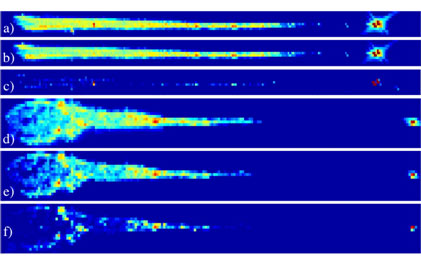Until 1974, Comet 81P/Wild 2 orbited beyond Jupiter, but a gravitational kick from that planet altered its orbit transforming it into a short-period comet in the inner solar system. This allowed NASA's solar-powered Stardust spacecraft to intercept the comet's tail within the orbit of Mars. The fly-by was completed at a relative speed of 6.1 km/s passing through the coma of the comet. Microscopic dust grains were captured in low-density silica aerogel tiles and aluminum foils, and these samples were returned successfully to Earth in January 2006. These Stardust samples are unique among extraterrestrial materials on Earth as the first samples returned from an identified parent body originating in the Kuiper belt beyond the gas giants. Due to the very recent orbit change, dust from Comet Wild 2 provides a means of inferring conditions in the Kuiper belt. It is expected that objects preserved in the frozen Kuiper belt are relatively unaltered since our solar system formed ~4.6 billion years ago. As a result, studies of Stardust particles offer a means of looking back in time to the origins of the solar system. First order, fundamental research involves understanding the elemental and isotopic chemistry, the astronomical signatures, the organics and mineralogy of these samples.
We studied the elemental chemistry of Stardust comet dust measured by synchrotron x-ray fluorescence. Historically, comet composition measurements have been made remotely or with poor resolution and detection limits due to the constraints of space-flown instrumentation. Micro-focused synchrotron x-ray fluorescence measurements (micro-SXRF) of comet dust on Earth offer enormous improvements over past measurements. 23 aerogel samples containing comet dust were analyzed using SXRF by the Preliminary Examination Team. This international collaboration provided the first look at the Stardust samples after the sample return, and results are presented in several publications by the Preliminary Examination Team in the December 15 issue of Science.

At SSRL, five Stardust samples were analyzed. Each sample contained a single comet dust impact track and was extracted from an aerogel tile in the form of a wedge-shaped "keystone". Impacting comet dust particles created tracks with a variety of morphologies and lengths and differing amounts of cometary material deposited along the path. Figure 1 contains optical micrographs of two of the keystones studied. Each Stardust comet dust impact track was mapped in the Beam Line 6-2 hard x-ray scanning fluorescence microprobe. Kirkpatrick-Baez focusing optics and adjustable virtual source slits produce a beam size of 2 x 2 microns2 with 109 photons/second (ph/s). For efficient mapping of Stardust impact tracks, the focused beam size was increased to 15 x 19 microns2 with 2x1010 ph/s. The K fluorescence lines of elements from Si through Br were accessible using 14 keV incident x-rays, and the microprobe end station is equipped with an optical microscope and low-Z mirror for x-ray line-of-sight viewing and sample positioning. Full fluorescence spectra were collected at each map pixel with dwell times of at least 30 seconds/pixel.

To provide an example of the data collected during these experiments, Figure 2 shows elemental maps of two different comet dust impact tracks. The upper three maps are from Track 4, a conical track with terminal particles. The maps show the Fe (top), Ni (middle) and Cr (bottom) abundances. Below those are the same (Fe, Ni and Cr) maps from Track 10. Track 10 has a bulbous entry region and a terminal particle well-separated from the initial entry region. From these data, the summed abundances of various elements can be determined both for the entire impact track and for the terminal particle. In some tracks, the total mass deposited is dominated by the terminal particle while in others, a significant portion is of mass is finely distributed along the length of the track. Significant differences between the elemental abundances of the whole track and the terminal particle require measurement of the entire impact track in order to assess the mean Wild 2 elemental composition.
Micro-SXRF is a powerful tool for the non-destructive analysis of the Stardust comet dust sample. In total, approximately 180 nanograms of Stardust comet dust was analyzed for bulk composition measurements during the Preliminary Examination period. The mean elemental composition of the Stardust Comet 81P/Wild 2 dust measured is generally consistent with the CI meteorite composition, believed to be representative of the overall composition of the solar system. A few elements, Cu, Zn and Ga, are enriched suggesting that the CI meteorites may not be entirely representative of the solar system composition for these moderately volatile elements. Given all that we have learned and the experiments planned, we expect to continue studying Stardust comet dust impact tracks for years to come.
G. J. Flynn, P. Bleuet, J. Borg, J. P. Bradley, F. E. Brenker, S. Brennan, J. Bridges, D. E. Brownlee, E. S. Bullock, M. Burghammer, B. C. Clark, Z. R. Dai, C. P. Daghlian, Z. Djouadi, S. Fakra, T. Ferroir, C. Floss, I. A. Franchi, Z. Gainsforth, J.-P. Gallien, P. Gillet, P. G. Grant, G. A. Graham, S. F. Green, F. Grossemy, P. R. Heck, G. F. Herzog, P. Hoppe, F. Hörz, J. Huth, K. Ignatyev, H. A. Ishii, K. Janssens, D. Joswiak, A. T. Kearsley, H. Khodja, A. Lanzirotti, J. Leitner, L. Lemelle, H. Leroux, K. Luening, G. J. MacPherson, K. K. Marhas, M. A. Marcus, G. Matrajt, T. Nakamura, K. Nakamura-Messenger, T. Nakano, M. Newville, D. A. Papanastassiou, P. Pianetta, W. Rao, C. Riekel, F. J. M. Rietmeijer, D. Rost, C. S. Schwandt, T. H. See, J. Sheffield-Parker, A. Simionovici, I. Sitnitsky, C. J. Snead, F. J. Stadermann, T. Stephan, R. M. Stroud, J. Susini, Y. Suzuki, S. R. Sutton, S. Taylor, N. Teslich, D. Troadec, P. Tsou, A. Tsuchiyama, K. Uesugi, B. Vekemans, E. P. Vicenzi, L. Vincze, A. J. Westphal, P. Wozniakiewicz, E. Zinner, M. E. Zolensky, "Elemental Compositions of Comet 81P/Wild 2 Samples Collected by Stardust", Science 314, 1731-1735 (2006).




